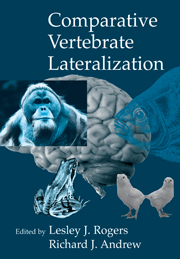Book contents
- Frontmatter
- Contents
- List of Contributors
- Preface
- Introduction
- Part one Evolution of lateralization
- Part two Development of lateralization
- Part three Cognition and lateralization
- 10 Evidence for cerebral lateralization from senses other than vision
- 11 Facing an obstacle: Lateralization of object and spatial cognition
- 12 Laterality of communicative behaviours in non-human primates: A critical analysis
- 13 Specialized processing of primate facial and vocal expressions: Evidence for cerebral asymmetries
- Part four Lateralization and memory
- Epilogue
- Author Index
- Subject Index
- Richard Andrew
12 - Laterality of communicative behaviours in non-human primates: A critical analysis
Published online by Cambridge University Press: 10 December 2009
- Frontmatter
- Contents
- List of Contributors
- Preface
- Introduction
- Part one Evolution of lateralization
- Part two Development of lateralization
- Part three Cognition and lateralization
- 10 Evidence for cerebral lateralization from senses other than vision
- 11 Facing an obstacle: Lateralization of object and spatial cognition
- 12 Laterality of communicative behaviours in non-human primates: A critical analysis
- 13 Specialized processing of primate facial and vocal expressions: Evidence for cerebral asymmetries
- Part four Lateralization and memory
- Epilogue
- Author Index
- Subject Index
- Richard Andrew
Summary
Introduction
In the past 12 years, there has been a resurgence of interest in the topic of laterality in non-human species (Bradshaw and Rogers, 1993). The resurgence of interest in this topic in a host of scientific disciplines was to some extent spurred by the review article written by MacNeilage, Studdert-Kennedy and Lindblom (1987) that called into question the prevailing view that population-level hemispheric specialization was all but absent in non-human species save songbirds (see Nottebohm, 1977; Warren, 1980). The theory proposed by MacNeilage, Studdert-Kennedy and Lindblom (1987) met with considerable criticism (see commentaries on the original article) but nonetheless resulted in a subsequent plethora of studies on laterality in non-human species, notably non-human primates (for reviews, see Fagot and Vauclair, 1991; Bradshaw and Rogers, 1993; Ward and Hopkins, 1993; Hopkins, 1996; McGrew and Marchant, 1997). The overwhelming focus of these studies was on hand preference and the determination of whether or not population-level biases were evident for specific kinds of sensory or motor tasks. Parallel to studies on hand preference but in substantially lower numbers were studies that focused on sensory or perceptual asymmetries (see Morris et al., 1993). As with studies of hand preference, the focus of these studies was largely the determination of population-level biases for specific tasks and the similarity in findings relative to humans. The purpose of the current chapter is to review studies that have examined perceptual asymmetries in non-human primates.
- Type
- Chapter
- Information
- Comparative Vertebrate Lateralization , pp. 445 - 479Publisher: Cambridge University PressPrint publication year: 2002
- 10
- Cited by



